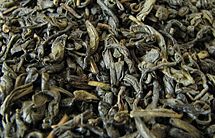- Chun Mee tea
-
Chun Mee 
Type: Green Other names: Chun Mei, Zhen Mei, 珍眉茶, zhēnméi chá, "precious eyebrow tea" Origin: Zhejiang, Anhui and Jiangxi in China as well as others Quick description: Dusty, acidic green tea Chun Mee (珍眉) is a popular green tea. It has a dusty appearance and is generally more acidic and less sweet than other green teas. It was originally produced only in the Jiangxi province, but is now grown elsewhere. It is often referred as "9371".
Chun mee tea, together with Assam Bukial tea, has been studied to study the rate of infusion of caffeine. The study found that caffeine diffusion through the tea leaves is a greatly hindered process.[1]
References
Tea Black tea Oolong tea - Bai Ji Guan
- Red Robe
- Darjeeling Oolong
- Dongding (Tung-ting)
- Dong Fang Mei Ren
- Huangjin Gui (Golden Osmanthus)
- Qilan tea
- Pouchong
- Rou Gui
- Shui Jin Gui
- Shui Hsien (Shui Xian)
- Tie Luohan
- Tieguanyin (Iron Goddess)
Green tea - Aracha
- Bancha
- Green Spiral
- Chun Mee
- Da Fang
- Genmaicha
- Liuan Leaf
- Gunpowder
- Gyokuro
- Hojicha
- Hou Kui
- Huang Shan Mao Feng
- Hyson
- Kabusecha
- Kamairicha
- Konacha
- Kukicha
- Longjing (Dragon Well)
- Matcha
- Mao Jian
- Mecha
- Meng Ding Gan Lu
- Sencha
- Shincha
- Tamaryokucha
White tea Yellow tea Post-fermented tea Blended and
flavoured teasTea culture Tea beverages Other - Camellia sinensis (tea plant)
- Tea bag
- Teapot
- Consumption
- Flowering tea
- Glass-holder
- Health effects
- Tea processing
- Samovar
- Tea brick
- Tea garden
- Tea house
- Tea tasting
- Teakettle
See also Categories:- Tea stubs
- Green tea
- Chinese tea
- Chinese tea grown in Anhui
Wikimedia Foundation. 2010.
